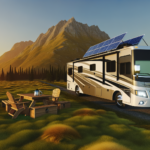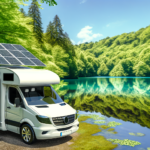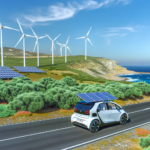Introduction to Solar Power for Adventurers
The Rise of Solar Power in Outdoor Activities
In today’s world, where sustainability and environmental consciousness are at the forefront of our minds, solar-powered gadgets have emerged as a game-changer for outdoor enthusiasts. These innovative devices harness the power of the sun to provide energy, making them an ideal solution for those who enjoy spending time in nature. The concept of utilizing solar power dates back centuries, but it wasn’t until the 19th century that the photovoltaic effect, which is the basis of solar energy conversion, was discovered. Since then, advancements in technology have enabled solar power to become more accessible and efficient, leading to its integration into various sectors, including outdoor gear and gadgets.
Why Solar Power Appeals to Adventurers
Solar power offers numerous benefits that make it particularly appealing to adventurers. Firstly, it provides **energy independence** and sustainability. Outdoor enthusiasts can generate their own energy, eliminating the need for traditional power sources. This independence allows adventurers to explore remote locations without relying on electricity grids or fuel-based generators. Additionally, using clean, renewable energy sources significantly reduces their carbon footprint, contributing to a more sustainable planet.
Secondly, solar power is **cost-effective** in the long run. While there may be an initial upfront cost, harnessing the sun’s energy can lead to substantial savings over time. Adventurers can eliminate the need to purchase disposable batteries or fuel for generators, making solar-powered gadgets a practical choice for those who frequently engage in outdoor activities.
Lastly, solar power is **eco-friendly**. By choosing solar-powered options, outdoor enthusiasts can contribute to the reduction of greenhouse gas emissions and combat climate change. Using solar energy for outdoor adventures aligns with the principles of Leave No Trace and promotes responsible outdoor recreation.
Overview of the Article
This article will delve into the economics of solar power, specifically focusing on the long-term savings for adventurers. We will begin by understanding the initial investment costs, operational and maintenance expenses, and how solar power compares to traditional power sources. Next, we will explore the long-term financial benefits, including reductions in energy bills, return on investment (ROI), and available incentives and tax benefits.
We will also discuss the environmental and social benefits of solar power, such as reducing carbon footprints, promoting sustainable living, and the broader community and global impact. Practical applications for adventurers will be covered, highlighting solar power solutions for camping, hiking, boating, and living off-grid.
Furthermore, we will guide you in choosing the right solar equipment by examining different types of solar panels, portable versus permanent installations, and evaluating efficiency and durability. Finally, we will conclude with a summary of long-term savings, future trends in solar technology, and final thoughts for adventurers.
By the end of this article, you will have a comprehensive understanding of how solar power can enhance your outdoor adventures while providing significant long-term savings and environmental benefits.
Understanding the Economics of Solar Power
Initial Investment Costs
The initial investment in solar power can be substantial, but it is crucial to understand what this entails. The primary costs include purchasing solar panels, inverters, mounting hardware, and batteries if you opt for energy storage. On average, a residential solar system can cost between $15,000 and $25,000 before any incentives or rebates.
However, there are various financing options available to mitigate these upfront costs. Paying for solar panels in cash yields the most long-term savings, as it avoids interest rates and fees associated with loans. Solar loans are another viable option, allowing you to spread the cost over several years while still benefiting from ownership incentives like the federal solar investment tax credit. Lastly, solar leases and power purchase agreements (PPAs) offer zero-money-down options, but they generally provide fewer savings over the system’s lifespan compared to ownership.
Operational and Maintenance Costs
One of the significant advantages of solar power is its low operational and maintenance costs. Once installed, solar panels require minimal upkeep. Regular cleaning to remove dust and debris, along with periodic inspections, are usually sufficient to keep the system running efficiently. Professional maintenance services can cost between $140 to $180, while annual inspections or cleanings are around $150.
Most solar panels come with warranties that cover performance guarantees, often lasting 20-25 years. This means that any significant issues are likely to be covered, reducing the financial burden of unexpected repairs. Additionally, solar systems have no moving parts, which minimizes the risk of mechanical failure and further reduces maintenance costs.
Comparing Solar to Traditional Power Sources
When comparing solar power to traditional power sources, several economic factors come into play. Traditional energy sources, such as coal, natural gas, and oil, are subject to market fluctuations and rising prices. Over the past decade, electricity prices have consistently increased, making solar power an attractive alternative for long-term savings.
Solar power offers a hedge against these rising costs. By generating your own electricity, you can significantly reduce or even eliminate your monthly energy bills. For example, the average U.S. homeowner who purchases a solar system in cash can save around $31,513 over the system’s lifespan. Even with a solar loan, savings can range from $21,513 to $26,513, depending on interest rates and loan terms.
Moreover, solar power provides energy independence. With the addition of battery storage, you can store excess energy produced during the day for use at night or during power outages, further reducing reliance on the grid. This not only offers financial benefits but also enhances energy security.
In summary, while the initial investment in solar power can be high, the long-term savings and low operational costs make it a financially sound choice. When compared to traditional power sources, solar power offers a stable and predictable energy cost, protecting you from market volatility and rising electricity prices.
Long-Term Financial Benefits
Reduction in Energy Bills
One of the most immediate and noticeable benefits of switching to solar power is the reduction in energy bills. As electricity prices continue to rise, solar energy offers a way to stabilize and even reduce monthly expenses. By generating your own electricity, you can significantly cut down on the amount you need to purchase from the grid. In some cases, especially with the addition of a solar battery system, you can achieve complete energy independence, eliminating your electricity bill altogether. Moreover, net metering allows you to sell excess electricity back to the utility company, further reducing your costs.
Return on Investment (ROI)
The initial investment in a solar power system can be substantial, but the long-term savings often justify the upfront costs. Typically, consumers can expect to break even on their investment within six to ten years. After this period, the electricity generated by the solar panels is essentially free, leading to significant savings over the lifespan of the system, which can be 25 years or more. Additionally, solar panels can increase the value of your home. According to the National Renewable Energy Laboratory, every dollar saved on energy bills can add $20 to your home’s value. Homes with solar panels also tend to sell faster and at higher prices compared to those without.
Incentives and Tax Benefits
Various incentives and tax benefits can further enhance the financial attractiveness of solar power. The federal solar investment tax credit (ITC) allows homeowners to deduct 30% of the cost of installing a solar energy system from their federal taxes. Many states also offer additional incentives, such as rebates and property tax exemptions, which can significantly reduce the net cost of a solar installation. For example, some states provide rebates that can cover a substantial portion of the installation costs, while others offer performance-based incentives that pay you for the electricity your system generates. These financial incentives not only reduce the initial investment but also shorten the payback period, making solar power an even more compelling option for adventurers looking to save money in the long run.
Environmental and Social Benefits
Reducing Carbon Footprint
One of the most significant environmental benefits of solar power is its ability to reduce carbon footprints. Traditional energy sources, such as coal and natural gas, emit large amounts of carbon dioxide (CO2) and other greenhouse gases when burned. These emissions contribute to global warming and climate change. In contrast, solar power generates electricity without producing any direct emissions. By switching to solar energy, adventurers can significantly lower their carbon footprint, making their outdoor activities more eco-friendly. This reduction in emissions is crucial for preserving the natural landscapes that adventurers cherish and explore.
Promoting Sustainable Living
Solar power is a cornerstone of sustainable living. For adventurers, adopting solar technology means embracing a lifestyle that minimizes environmental impact. Solar-powered gadgets, such as portable chargers, lanterns, and water purifiers, allow adventurers to harness renewable energy from the sun, reducing their reliance on disposable batteries and fossil fuels. This shift not only conserves natural resources but also aligns with the principles of “Leave No Trace,” which advocates for minimizing human impact on the environment. By integrating solar power into their gear, adventurers can lead by example, demonstrating that it is possible to enjoy nature responsibly and sustainably.
Community and Global Impact
The benefits of solar power extend beyond individual adventurers to communities and the global environment. On a community level, the adoption of solar energy can reduce the overall demand for electricity from the grid, especially in remote areas where access to traditional power sources is limited. This can lead to lower energy costs and increased energy security for local populations. Additionally, many regions offer net metering programs, allowing individuals to sell excess solar energy back to the grid, further supporting community energy needs.
Globally, the widespread adoption of solar power can play a significant role in combating climate change. By reducing the reliance on fossil fuels, solar energy helps decrease global greenhouse gas emissions. This collective effort is essential for meeting international climate goals and ensuring a healthier planet for future generations. Moreover, the growth of the solar industry creates jobs and stimulates economic development, contributing to a more sustainable and resilient global economy.
In summary, the environmental and social benefits of solar power are profound. By reducing carbon footprints, promoting sustainable living, and supporting community and global initiatives, solar energy empowers adventurers to make a positive impact on the world while enjoying the great outdoors.
Practical Applications for Adventurers
Solar Power for Camping and Hiking
For adventurers who love camping and hiking, solar power offers a reliable and eco-friendly energy solution. **Portable solar panels** and **solar chargers** are lightweight and easy to carry, making them perfect for backpacking trips. These devices can charge essential gadgets like smartphones, GPS units, and cameras, ensuring you stay connected and safe even in remote locations. Additionally, solar-powered lanterns and cookers can enhance your camping experience by providing light and a means to prepare meals without relying on traditional fuel sources.
Solar Solutions for Boating
Boating enthusiasts can also benefit significantly from solar power. Installing **solar panels on boats** can help maintain battery levels, power navigation systems, and run onboard appliances. This not only reduces the reliance on fuel but also minimizes the environmental impact of boating. Solar panels are particularly useful for long voyages where access to traditional power sources is limited. Moreover, solar energy systems on boats are low-maintenance and can withstand harsh marine conditions, making them a durable and cost-effective solution for seafarers.
Living Off-Grid with Solar Power
For those who dream of living off-grid, solar power is an indispensable resource. **Off-grid solar systems** can provide all the electricity needed for a self-sufficient lifestyle, from powering homes to running water pumps and heating systems. These systems typically include solar panels, batteries for energy storage, and inverters to convert solar energy into usable electricity. While the initial setup can be costly, the long-term savings and independence from traditional power grids make it a worthwhile investment. Additionally, living off-grid with solar power promotes sustainable living and reduces one’s carbon footprint, aligning with the values of many eco-conscious adventurers.
In summary, solar power offers versatile and practical applications for adventurers, whether you’re camping in the wilderness, sailing the seas, or living off the grid. By harnessing the sun’s energy, you can enjoy your adventures with the peace of mind that comes from using a clean, renewable, and reliable power source.
Choosing the Right Solar Equipment
Types of Solar Panels and Their Uses
When selecting solar panels for your outdoor adventures, it’s essential to understand the different types available and their specific uses. The two most common types of solar panels are **monocrystalline** and **polycrystalline** panels.
– **Monocrystalline Panels**: These panels are made from a single crystal structure, making them more efficient and space-saving. They are ideal for adventurers who need high efficiency in a compact form, such as those using solar panels on backpacks or small RVs.
– **Polycrystalline Panels**: These are made from multiple crystal structures and are generally less efficient but more affordable. They are suitable for larger installations where space is not a constraint, such as on boats or larger RVs.
Additionally, there are **thin-film solar panels**, which are lightweight and flexible, making them perfect for portable applications like camping and hiking gear.
Portable vs. Permanent Installations
Choosing between portable and permanent solar installations depends on your specific needs and the nature of your adventures.
– **Portable Solar Panels**: These are designed for ease of transport and quick setup. They are perfect for camping, hiking, and short-term trips. Portable panels often come with foldable designs and built-in handles, making them easy to carry and set up. Examples include solar-powered backpacks and foldable solar chargers.
– **Permanent Solar Installations**: These are more suitable for long-term use and are typically installed on RVs, boats, or off-grid cabins. Permanent installations provide a stable and continuous power supply, which is crucial for extended stays in remote areas. They require a more significant initial investment and professional installation but offer higher efficiency and reliability.
Evaluating Efficiency and Durability
When choosing solar equipment, evaluating efficiency and durability is crucial to ensure you get the best performance and longevity.
– **Efficiency**: The efficiency of a solar panel determines how much sunlight it can convert into usable electricity. Monocrystalline panels generally offer the highest efficiency, followed by polycrystalline and thin-film panels. Higher efficiency panels are beneficial when space is limited, as they generate more power per square foot.
– **Durability**: Durability is essential, especially for adventurers who expose their equipment to harsh outdoor conditions. Look for panels with robust construction, weather-resistant features, and a good warranty. Panels with tempered glass and sturdy frames are more likely to withstand the rigors of outdoor use.
In summary, choosing the right solar equipment involves understanding the types of panels available, deciding between portable and permanent installations, and evaluating the efficiency and durability of the panels. By considering these factors, adventurers can ensure they have a reliable and sustainable power source for their outdoor activities.
Conclusion and Future Outlook
Summary of Long-Term Savings
For adventurers, the long-term savings from investing in solar power are substantial. By transitioning to solar energy, you can significantly reduce or even eliminate your energy bills. The initial investment, while considerable, is often offset by various incentives and tax benefits, leading to a quicker return on investment (ROI). Over the lifespan of a solar system, which typically ranges from 25 to 30 years, the cumulative savings can be substantial. For instance, in regions with high electricity rates, the savings can amount to thousands of dollars annually. Additionally, the value of your property may increase, making solar not just an energy solution but a financial asset.
Future Trends in Solar Technology
The future of solar technology is bright and full of promise. Innovations are continually emerging, making solar panels more efficient, durable, and affordable. Here are some key trends to watch:
- Increased Efficiency: Advances in photovoltaic technology are pushing the efficiency of solar panels beyond current limits, allowing for more energy capture from the same amount of sunlight.
- Energy Storage Solutions: The development of more efficient and cost-effective battery storage systems will enable adventurers to store excess energy for use during cloudy days or nighttime, enhancing the reliability of solar power.
- Portable Solar Solutions: Lightweight, flexible, and portable solar panels are becoming more prevalent, making it easier for adventurers to harness solar power on the go.
- Integration with Smart Technology: Solar systems are increasingly being integrated with smart home technologies, allowing for better energy management and optimization.
- Cost Reductions: As technology advances and production scales up, the cost of solar panels and related equipment is expected to continue to decrease, making solar power more accessible to a broader audience.
Final Thoughts for Adventurers
For adventurers, the shift to solar power is not just a practical choice but a transformative one. It aligns perfectly with the ethos of sustainable living and environmental stewardship. By investing in solar technology, you are not only ensuring a reliable and renewable source of energy for your adventures but also contributing to a larger global movement towards sustainability.
The economic benefits are clear: reduced energy costs, potential property value increases, and various financial incentives make solar a wise investment. Moreover, the environmental impact is profound, as you reduce your carbon footprint and promote cleaner energy practices.
As you embark on your adventures, consider the long-term benefits of solar power. Whether you are camping, boating, or living off-grid, solar technology offers a reliable, cost-effective, and environmentally friendly energy solution. Embrace the future of energy and let the sun power your adventures.





